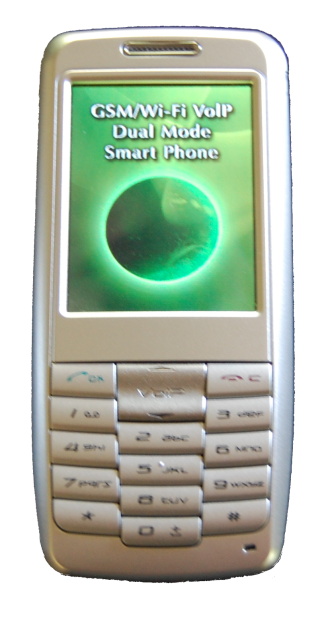
The
Skyvoice S282 GSM/WiFi Phone
goes
by several different names
Linuxslate.com
Review:
Dual Mode GSM/VoIP WiFi Phone
Discuss
this article in the
Linuxslate.com
Forums
September 2009
UPDATE: November 2009:
Linuxslate.com Forum Member simonv has provided more information on this phone.
This article has been updated accordingly, and new links have been included. More
Information will follow on either the forums or in the form of a How-To Guide
in the Guides & Help Section of this website.
|
Contents:
|
 The
Skyvoice S282 GSM/WiFi Phone |
Introduction:
Several
years ago, I became aware of a Chinese company that was doing some
pioneering work on Linux based mobile phones. While many of
E28's designs never
materialized, they had produced at least 2 models
that were sold in Asian markets. In addition to giving E28
credibility, the 2 phones seemed quite compelling for their time, even
though they
lacked QWERTY keyboards, and big screens.
For several years now I have wanted to review one of E28's phones on this website. Emails to E28 went unanswered, and the really cool models they talked about never materialized. I was not able to buy even the base models. I would have had to pay a very high price, fly to China, or buy 10,000 of them.
When the iPhone, and latter the Google Android phones hit the market I, for the most part, stopped following E28. Now I have finally been able to buy one of these phones at a reasonable price. What are the E28 phones like? How is the quality of the software? What features do they have? How does the VoIP functionality work? Are there any real advantages to it?
|
The
phone reviewed here is branded as the Skyvoice
model S282.
It appears physically identical to the E28 Model R2821
(Pictured here from E28's Web site, now apparently
discontinued.) We'll see later
that it is in fact the E28 phone.
It has been brought to my attention that this phone is also sold as the
VuTek DP72 (website link at end of article). The specs are shown to the
right. 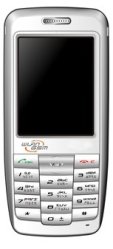 The
E28 R2821 looks identical to the
Syvoice S282 reviewed here. The
idea behind this phone, and in
fact the entire idea of E28's business was the idea of calls
automatically handing over from GSM to VoIP/WiFi when a WiFi connection
was available, and back again when WiFi was no longer
available. This would require a special
VoIP service that could route the calls as needed. Skyvoice is primarily a VoIP provider, and does not
seem to offer any type of handover from GSM to
VoIP. With
Google Voice, it is
possible to have 1 phone number associated with the
phone whether it is connected via WiFi/VoIP or GSM, but in-call
handover is not currently possible as far as I know. Either
function can be used independently, so the S282 can be used as just a
GSM mobile phone, or just a WiFi handset. The E28 R2821 has been approved here in the US by the FCC, but there is no FCC sticker in the Skyvoice branded phone I received.
|
|
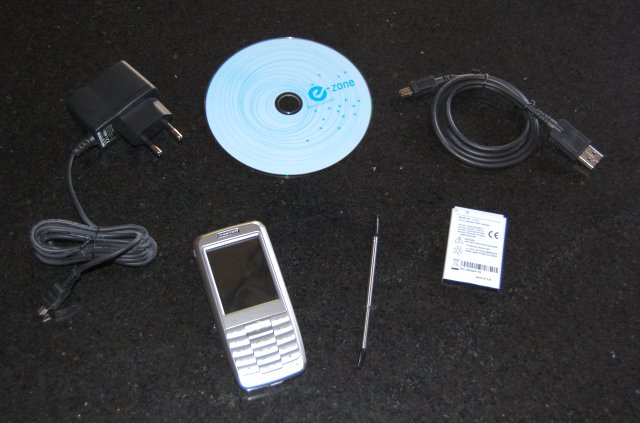
|
Skyvoice
S282
Box Contents |
|
|
|
Exterior
Features
Front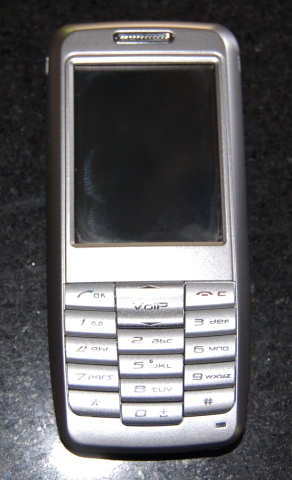
The S282's 2.2 inch 240 x 320 display is as bright and sharp
as
any name brand phone, but direct sunlight still causes
problems. It's a resistive touch screen, meaning you need
a
stylus or fingernail to use it. Touch activation is possible
on
some items, but due to the small size of most on-screen buttons, you
are
going to be pulling out the stylus most of the time. Below
the screen is a 2 way (up,down) rocker. It serves as
the volume control during calls, and
allows limited navigation thru menus. The fact that it is not
a 4 way pad, and has no center press, limits the on screen
navigation you can do, and may cause problems in some java applets.
To the left and right of this rocker are the standard Call
(yes)
and Hangup (no) buttons. These function as expected, and also
work for navigating some, but not all on screen items. The
remaining keys form a standard phone keypad (now obsolete in my
opinion.)
The small size and candybar style makes the phone easy to hold and
carry. It certainly is not a quality phone, but it is free from case
creaks, gaps or any unfinished appearance.
Side
The right side
has a small recessed
power/unlock key. While this is a rather inelegant
solution
to the problem of accidental key presses,
it does work. Below this key is the stylus storage. The phone
sleeps and locks the keys as it should. There
are no side volume keys or scroll wheel
(Grrrrrr.).
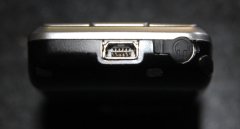
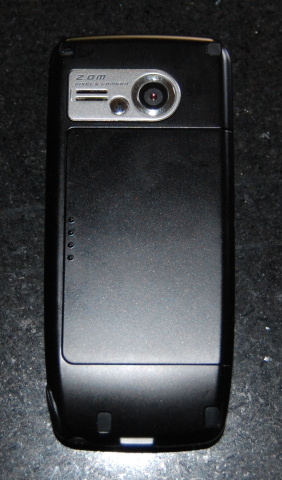 Bottom
Bottom
The bottom contains a standard Mini USB connector for data and charging
and a 2.5 mm headset jack. More on USB functionality can be
found later in this article.
It's nice to have these 2
standard connectors. A 3.5 mm jack would be
nice, but readily available adapters will allow connection of standard
audio cables, headsets and headphones. An adapter cable I
made years ago for another phone worked fine with this phone, so that
tells us that the 2.5 mm connector has a standard pin-out.
The
included stereo headset has a mic and the standard answer/hangup button.
Back
The back contains the 2 mega pixel camera, a tiny self-viewing mirror,
and the speaker. There is no camera shutter, and no flash. There is a
place for a
carry strap or phone charm at the top. The battery door is
very thin, and not very structurally sound. I suspect that it will not
be long until the
door cracks, or simply does not stay in place.
Internal
Inside the battery cover is the
sim card slot, as well as a standard micro SD (Transflash) card slot.
The micro
SD
card is not hot-swappable as both the rear cover, and the battery must
be removed to access it. I have only tested a 1 Gig card, but
cards up to at least 4 Gig should work fine. I did initially
have difficulty getting the S282 to recognize the Micro SD card. After
a few tries, it
suddenly started seeing the card, and allowed me to format it.
Basic
Phone Functionality:
Sound
and RF Quality
Basic sound quality as a GSM phone is fine. Signal reception
is on par with other GSM phones.
With even 1 bar, calls connect, and generally stay connected.
I
strongly suggest users buy unlocked phones, and such was the case with
the S282 reviewed for this article. It will work on any GSM
service in the world. Around here, that means AT&T or
T-Mobile. Interesting,
AT&T's network here in the US (MCC 310 MNC 410)
is not pre-programmed into the S282. This means that on AT&T,
the network name will likely be blank for many subscribers.
T-Mobile's network name seems to appear properly. The
fact that
AT&T's name is not shown does not affect the ability to use the
phone.
Quad
Band GSM
This phone is a Quad Band GSM phone (850/900/1800/1900 MHz).
It lacks any 3G capability, although it does have WiFi.
In fact with WiFi on board, you may opt for no data plan.
If
you do have a data plan, you will find that this phone has GPRS only.
It does not support EDGE. In today's 3G
world,
stepping all of the way back to GPRS may seem like a show stopper.
Given that the Web capabilities of the phone are pretty
basic,
and the fact that it does have WiFi, this limitation may not be much of
a problem, depending on your planned use.
User
Interface and Basic Use
There
are more technical details on this phone's Operating System latter in
this review, but for here I will say that it is simple and easy to
navigate. Setting up GSM/GPRS and WiFi networks is about as
simple
and
straight forward as possible. There are no complicated
profiles
for GPRS, MMS and WAP settings. Using
features such as Contacts, Calendar, Messaging, and most other basic
features is user friendly and responsive. Photos and
custom
ringtones can be added to individual contacts. Custom ring
tones in a
standard Midi or MP3 format are supported, and you can select different
alerts for Calls, Calendar alerts, and Messages. Several
"Themes"
are included, but there is not much to what they call a "theme".
Missing
Features
Sadly, E28 has
never actually released a high end phone. This phone seems to go out of
it's way to prove that. Features such as voice dialing, and cut
and paste are missing. The worst problem with the S282 is that there
seems
to
be no provision for setting the clock from the network - either on GSM
or WiFi. Worse than
that, every time the battery is removed () or runs down completely, the
time is lost and must be re-entered. Remember that removing the battery is necessary to
access the sim or the SD card.
It is amazing to me that
a
phone apparently marketed primarily to a Chinese audience is missing
such basic
features.
Messaging
SMS
and MMS work as expected. There is support for up to
4
email
accounts, but only POP/SMTP email is supported.
MMS, WAP and
GPRS Settings
for AT&T (US) are listed below:
| Go to:
Menu
--> Tools and Setup --> Internet Setup -->
connection setup --> User defined. MMS Settings --> MMS center: http://mmsc.cingular.com Main MMS gateway: 66.209.11.32 Alt MMS gateway: [Leave all 0's.] Wap Settings --> Main WAP gateway: 66.209.11.61 Alt WAP gateway: [Leave all 0's.] GPRS Settings --> GPRS web Access point name: wap.cingular Username: wap@cingulargprs.com Password: CINGULAR1 [Case sensitive] Same settings need to be entered again for GPRS WAP and GPRS MMS. If you plan on AVOIDING DATA CHARGES by only using the S282's data features only while on WiFi, then simply DO NOT enter the settings for GPRS, GPRS WAP or GPRS MMS, and/or call your mobile provider and ask them to block data. |
Languages
As
tested, the Skyvoice S282 supports English and
Chinese. The on screen keyboard supports
Chinese and Roman characters regardless of the language settings.
There is also character recognition, but apparently only for
Chinese characters.
| VoIP
Setup The S282 integrates a standard SIP VoIP client into the phone. Other protocols Like H.323 are not supported. The settings available for VoIP are limited. There do not seem to be any settings for NAT transversal (Like STUN), but My VoIP provider (and numerous others) do not use STUN. The settings for Skyvoice are set by default, but adding additional ones is easy. Remember that WiFi must be set up prior to VoIP working, and the WiFi network must not block the ports your VoIP provider uses for SIP. VoIP over GRPS is not supported. VoIP over GRPS would not work acceptably and it also violates most wireless provider's terms of service. The settings, and their values for Callcentric are listed below:
|
Perhaps it is more
fair to compare the Skyvoice S282 to a WiFi VoIP handset such as the
Zyxel P-2000W
|
||||||||||||||||||||||||||
VoIP calls to Fixed and GSM numbers from the S282 via Callcentric have good quality, and are free of excessive lag. Using keypad touch tones (DTMF) during a call worked first shot.
Making
VoIP calls with no sim card installed is an impressive
demonstration. If you have
a VoIP service that will give you a free incoming number (called a
DID), completely free incoming calls are possible. A Google
Voice
account tied to a Gizmo account may be one way to do this. Callcentric
has DID's for US$3 per month.
Free VoIP calls are not the
only thing you can
do with your S282. Here's how to send and receive unlimited text
messages (SMS) for free on your S282: You'll need a Google
Voice
account as mentioned above and (obviously) access to WiFi.
You
can then use the S282's browser to go to:
http://www.google.com/voice/m
SMS messages sent to your
Google Voice number will be seen there, and you can send them too.
Sure, any phone with a data
plan can go to the same Google Voice Mobile page. It's the
fact that the S282 has WiFi that makes it totally free.
While many high-end phones have WiFi, and VoIP apps for some of those phones are available, the S282 can be had for about the one-third of the price of other unlocked WiFi phones.the S282. Also keep in mind that the S282 is smaller and lighter than even most WiFi equipped PDA's.
If you only make an
occasional call while not in range of WiFi, you can put a pay as you go
sim in the S282. It should also be possible to make emergency
only calls with a non-registered sim in the phone. WARNING:
VoIP
services may not have emergency (911) service. Even if they do, the
information that appears on the emergency operators screen may
not be where you actually are when you carry your S282 with you.
PIM (PDA)
Functionality
Basic PIM
(Personal Information
Manager) functionality is included on the S282. This includes
Contacts, a basic 4 function Calculator, Memo pad, Calendar, World
Clock and Alarm Clock. These last three apps are somewhat
useless
given that the device will not set itself to the correct time/date.
Also included is a English <--> Chinese
dictionary.
The Memo application deserves additional mention since in addition to text notes (which can be sent as an email, SMS, or MMS), it also supports voice memos, and drawings. The drawing feature is remarkably advanced. It includes adding text, frames stamps, and dialog clouds (like a cartoon) to a picture. Rotation, and limited editing, are some of the other features. It's a bit of a savant in a phone that cannot even tell time. In addition to allowing you to make quick hand written scribbles, it will keep kids occupied for hours.
The CD that is provided with the phone includes PC synchronization software, but is for Windows only. Without Bluetooth, other options for getting your contacts, etc. into the phone are limited. I have still found no way under Linux or Mac OSX to sync contacts, etc. The disk also contains English and Chinese user manuals in PDF.There is no PDF reader on
the phone, or compatibility with
Microsoft Office
products, but I would not expect that on a phone this basic.
When
you format an SD card, it does create a folder called eBooks, but I am
not sure what formats it expects or what app will open them.
Java
book readers and simple document viewers should work on this phone.
Media
Player Functionality
Music
Player
The Skyvoice S282 is a fairly functional media player. The Music Player
plays at MP3, MIDI and WAV. (The voice recorder
records and plays mono audio in the AMR
format.) The MP3 player is
basic, but looks nice and functions well. It calls a
temporary
selection of files a playlist, but there is no way to
save
or edit real playlists. A very simple random play (shuffle) is
supported.
There is no equalizer or bass boost, but audio
quality is
good, and there is plenty of volume. The top portion of the
screen can be set to
display
the Song, Artist, and Album information, or to one of several graphic
effects. The effects move as music plays, but there is no real
synchronization to the sound. This phone does not multi-task. Leaving
the music player stops the music.
Gallery
Pictures
taken with the camera or loaded onto the SD card can be viewed in the
Gallery as on most phones. Slide show functionality is
included and
as mentioned, pictures can be edited in the Drawing part of the memo
app, where
frames, stamps, and a variety of silly things can be pasted on top.
Video Player
The manual says that the Video player supports 3GPP, and MP4 at QCIF or
QVGA resolutions. A MP4 h.264 file of arbitrary resolution
that plays fine on an iPod or Google Android phone would not play on
the S282, but I have no reason to believe that properly encoded MP4
files would not play. A 3GPP test file played fine. Movies
can be played fullscreen landscape.
Camera: Still Shots
| The S282 includes a fixed focus 2 MP camera sensor (1600x1200 Max Image Size). There are settings for brightness as well as features such as Sepia and Black & White shooting. There are several settings for resolution, and digital zoom is available up to the highest resolution. There is a self-shot timer with settings up to 15 seconds. While this is certainly nothing like the camera in the Motorola ZN5 (Reviewed here), the camera is better than one might expect for a basic phone. Sample pictures shot in bright sunlight are shown at the right. Theses were shot at 640x480 and the full size picture can be seen by clicking the thumbnails. |   |
Camera: Video Recording
The S282 supports video
recording, including audio. Two resolutions are available, HQ
(
176 x144) and MMS (128 x 96). Photos and video
can be attached to an MMS or email message.
Internet Connectivity and Web
Browsing
This phone includes a version of the Opera mobile browser.
It's very similar to Opera on other similar phones such as
the
Motorola EZX phones or some Nokia Symbian phones. In the
menus,
there is a separate item for a WAP browser, but it looks to me like you
get the same Opera no matter which you launch. The WAP
browser
has separate WAP Gateway settings.
There
is no zoom or full screen function, but there is a wrap function that
makes pages fit to the screen width. Pages can be loaded
without
pictures in case you are on a pay as you go data plan.
The
browser is limited by a few factors on this phone. First,
since
there is no 4 way button pad (D-pad), navigation is a little harder
than it would otherwise be. Horizontal scrolling must be done
with the stylus. Secondly, if WiFi is not available, we are
limited to GPRS for our data connection. Third, the phone has
limited memory. The end result is that WAP, or mobile
specific
web pages work fine, but forget about more complicated, or non-mobile
websites. Again, we have to be realistic in our expectations
here. This is no iPhone or Google Android device, and cannot
surf
the Web like they do. Compared however to standard Symbian
S60
phones or to most Motorola phones (even some current high end devices
like the ZN5), this phone is right up there. The WiFi
capability
pushes this past many phones in it's class.
The browser works when
connected via GPRS or
WiFi. You can use the browser while waiting for a VoIP
call. Opera recognizes a large variety of standard file types,
and
may
standard files will open, or can be downloaded. If the phone goes to
sleep during a download, it seems to crash the browser (or worse.)
Finding and joining WiFi networks is easy and well implemented.
When you first join a WiFi network, you can select which VoIP provider
to use.
These settings are remembered, and the phone will automatically
connect and register on VoIP when a remembered network is available.
WiFi status (WiFi Off, WiFi Active, but not connected, WiFi Connected,
and WiFi Connected with VoIP Registered) is shown in the status bar at
the top of the screen. WiFi range is good and
associating
to access points (AP's) is fast.
The top of the screen has the standard indications for the mobile
network signal, and GPRS connection and data activity.
The lack of Bluetooth was a big
disappointment for me. My
research indicates that the phone may have Bluetooth hardware, but
there is no Bluetooth capability in the phone as tested
here.
Adding
Applications
Native Applications
There is no included installer
for
native apps, and as far as I know, none available other than what is
included.
In theory, it should be possible to
install native Linux applications on this phone. It is even
possible that some apps for devices like the Motorola A560, A780, A1200
could work or be made to work. (See the
"Yes,
but Does it run Linux" section of this review.)
Java
Applications
While Native apps are not available, this phone will run Java applets.
2 games (Chinese language) are included. As
mentioned, not
having a 4 way pad makes using some java applets awkward, but java apps
that use the keypad numbers for navigation should work fine.
If a
java app is touch screen avare, then it will probably support
the
touch screen on this phone. Java apps can access the network
over
GPRS or WiFi. Again, memory is limited, so complex java apps
will
slow down or simply crash.
Unfortunately,
one such app is Google Maps for Mobile. It
loads but is not stable or usable on this phone. It may be
possible to find an older version that works.
Websites
that distribute java apps can be directly entered into the Java system,
or
.jad or .jar files can be installed from basically any method of
getting them on the phone.
Battery Performance
It's not the fault of the S282/R2821, it just a fact: WiFi
use drains batteries quickly. Even with no calls,
but
connected to WiFi, or searching for WiFi access points, the S282 will
barely last through a 12 hour day. Obviously, also
making GSM calls throughout the
day,
or media use makes this worse. WiFi and GSM can be
turned on and off separately. In the S282, "Antenna
Off" (We here in the US call it "Airplane Mode") only refers
to
the GSM radio. WiFi may still be active, and each must be
turned
off separately. If you know you will not be in range
of a
WiFi access point for a time, turning off WiFi extends battery life
significantly. I did not test GSM only standby time of this
phone, because, well, that is kinda not the point.
USB
The Skyvoice S282/ E28 R2821 has a conventional Mini USB connector at
the bottom center. It has several different functions:
Charging
The S282
is charged via USB. Until you specifically
select one
of the USB functions listed below, the S282 will not do anything except
charge when connected to USB. The S282 will not get into
loops of
continuously disconnecting and reconnecting to devices, and absolutely
anything with standard USB power will charge the S282.
Charging
will continue while any of the 3 modes below are in use.
USB Network Mode
The
"Connect PC" Menu offers 2 choices of Modes for the USB port.
The
first is called "Mobile Device". This mode is intended to be
used
with the PC Sync software on the Disk. It actually creates a
USB
Networking connection to the host PC for Contacts, Calendar , etc.
sync'ing. More technical details below.
USB Storage Mode
The
other choice in the "Connect PC" Menu is "USB Mass Storage". As this
implies it makes the S282 a standard USB sorage device. Only
the
Micro SD card is available, and this function does not work if there is
no card. Various types of standard files can be dragged and
dropped to the card, and then used in the phone. This is one
of
the features that makes the S282 a capable media device.
Memos, Voice recordings, Pictures taken with the camera, and
drawings are in standard formats and can simply be dragged off the
storage card to any PC regardless of Operating System. Only USB 1.1 is
supported, so expect those large
media files to take a while to copy over. When I want to load
up
the S282 with media files, I remove the card and put it in a USB 2.0
card reader.
Modem Mode
In
a menu that is separate from the 2 modes above is a Modem mode.
In this mode, the S282 will function as a GPRS modem for a PC
or
laptop. It works with standard "AT" commands, and setting up
tethering is done as it is with other phones that support tethering.
Remember, however that only GPRS is available,
so data rates will be low.
Yes,
but Does it Run Linux?
Note:
This section is intended for those interested in Linux and
some
more technical details about these phones. General
users/purchasers can
skip
to the Conclusion.
So
why is this basic phone featured here on Linuxslate.com?
Well, with Linux inside, and a stylus touch screen, this is a
Linux slate. How do I know it runs Linux? What
Linux does
it run? What features/hacks can I do?
E28, Triva,
and GPL Violations.
(Skip this section)
E28,
and by association, this phone, has a bit of a sordid history.
This may be part of the reason that we have not (at
least
not yet) seen great products come from E28. E28 was founded
by
Roger I. Kung. Mr.
Kung worked for Motorola from 1976 to
1994,
and worked extensively on the 1st generation Motorola Linux (MING)
phones (Such as the E680, A760, and the A780). These
Motorola
phones run something called EZX Linux, which is a Motorola modified
version of MontaVista Linux.
The R2821 (and thus the
phone
as reviewed here) run E28's version of MontaVista Linux. There was a
bit of friction early on when Motorola began using their own version of
MontaVista instead of sticking with MontaVista as MontaVista
intended it. This part has nothing to do with E28, but the fact that
Mr. Kung worked for Motorola, and then formed a
company that sold phones with very similar hardware and software, was
not looked on too favorably by Motorola. Lastly, there have
been
questions of GPL violations by E28. As of the time of
research for this article, there is no mention of
the
GPL on E28's website, and I could not find any source code. The phone
as I received it did not include a copy of the GPL, or any mention of
it, or any link to source code. Similarly, the Skyvoice
website
does not mention the GPL or anything about source code.
I
would very much like to see E28 succeed. Linux on mobile
devices,
which has since become extremely successful, probably owes more to Mr.
Kung than is widely understood. Never the less, I encourage
E28
and Mr. Kung to play by the rules. Other companies that are
using
Linux on mobile devices, and abide by the GPL, such as Google, HTC,
Motorola, and Nokia have been very successful. E28 may find
much
more success if they too abide by the GPL.
Linux on the
S282/R2821
The
filesystem of this phone is all too easily explored by use of the
file:/// protocol on the included Opera browser (See Security, below).
It shows a customized version of MontaVista Linux.
It's
based on a 2.4.20 kernel. In fact one of the reasons for my personal
interest in this phone, and why I am writing about it, is to
document
an example of a consumer device with
closer to a "pure" MontaVista embeded Linux. E28's name is
all
over many of the settings files, showing that SkyVoice has probably
done very little to the OS.
The
successor to this phone is the E28 E2831, sold in Europe as the
Neuf Twin (Twin referring to the dual VoIP/GSM functionality, just as
with the R2821.) There is a French Language website dedicated to
providing an open replacement for the Neuf Twin's firmware (See Links,
Below). Many of the tools and instructions on the OpenTwin
website should be helpful in modding the R2821, or in recovering one
that has had it's filesystem corrupted. More information on this
as I work with it. Check the Linuxslate.com Forums for the latest developments. I'll post instructions on the Guides & Help page if/when I have more information to post.
UPDATE: Telnet Access! Please see This Thread on the Forums:
Security, one of the "Missing Features"
For
those wishing to break into the world of Jailbreaking
and unlocking the iPhone and other devices, I would suggest
that you start with this device. It's likely pretty easy. The
ability to browse the
filesystem from the browser by using the file:/// syntax is just the
beginning. Other
than some of the standard entries in /etc/passwd, there is no user such
as "mobile", or another non-privileged user. This means that
all
apps, including the browser are apparently running as root.
In short, few of the security
features
Linux provides are being used. Also settings such as the
user's
VoIP password are visible in plain text in the settings files.
Hardware
The S282/R2821 is built on the TI OMAP730
SOC (System on Chip).
AT command and
USB Networking.
The
S282 supports standard AT commands (With the GSM additional functions)
in modem mode. In "Mobile Device" mode, it creates a standard
USB
network connection. The devices address is 169.254.0.2, and
it is
listening on port 650 (obex). So the PC sync software
apparently uses
obex/syncml to exchange contacts, etc.
I've had some initial luck browsing the device using obexftp.
There do not seem to to
be any open ports on the WiFi connection.
Java compatibility is
provided by the Esmertec jbed JavaME
Virtual Machine
Conclusion
The S282 is simultaneously one of the worst cellphones I've seen in
several years, and one of the coolest WiFi/VoIP handsets. It's one of the smallest Multi-use
devices with WiFi out there, and
a very
usable WiFi/VoIP handset, with far more features than other WiFi/VoIP
handsets that cost much more. It's also a small, but functional media
player and digital camera. What are the features other
than the GSM phone worth to you? If you can get one
for that price or less, go for it.
Links:
E28 Website
Skyvoice Website
- VoIP provider, offers the S282 for sale, or with VoIP plans.
VuTek Website - The VuTek DP72 is the same phone.
VuTek Support Page - has Firmware and manuals for the VuTek DP72 - Warning: This firmware will re-brand your phone,
and possibly do much
worse. I have not tested this firmware.
OpenTwin Website - French language - Website and Wiki dedicated to hacking and customizing the Neuf Twin.
The Neuf Twin is a branding of the E28 E2831, which
is the R2821's successor.
Some
tools/info found there may be help in modding/restoring the S282/R2821.
Google
Voice
Callcentric
- VoIP provider.
Roger
I. Kung E28 Chairman & CEO
MontaVista Linux
TI
OMAP730
Wikipedia
page on Emertec (Now Myriad Group)
Discuss
this article in the
Linuxslate.com
Forums
|
Disclaimer:
|
All trademarks/tradenames are the property of the companies that own them.